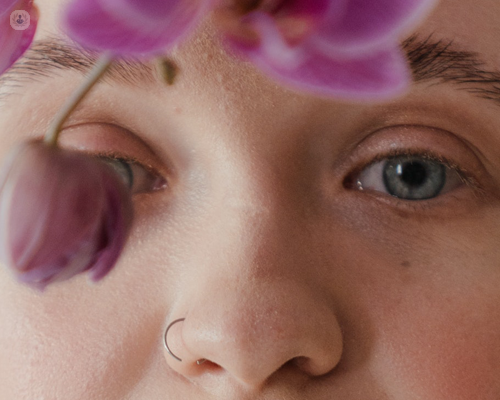Recognising diabetic retinopathy
Autore:Diabetes may have a variety of side effects, especially if the condition is not managed appropriately. One of these side effects is another condition called diabetic retinopathy, which can have major effects on vision. In this article, highly experienced consultant ophthalmologist Mr Alistair Laidlaw educates us on how to recognise this condition, or even better, how to catch it early.

What exactly is diabetic retinopathy?
Diabetic retinopathy is a condition that affects the retina as a result of diabetes. The retina is the light-sensitive membrane inside the eye; it's like the chip in the camera or the film in a camera. The blood vessels in the retina are damaged by diabetes, glycaemic control, blood sugar control, blood pressure, and to an extent lipids, and the duration of diabetes over time.
It manifests itself in two important ways:
- It can cause blurring of vision due to the central part of the retina, the bit that we recognise faces with or read with, becoming involved, often with leakage of the blood vessels and swelling.
- As a result of that impaired function and clarity of vision, there is growth of new blood vessels. This is a very important aspect of diabetic retinopathy because it can lead to bleeding in the eye and a form of retinal detachment.
Diabetic macular leakage in the centre can be very, very handicapping when patients find they can't read or recognise faces. It's obviously very, very important. The proliferative retinopathy, the growth of new blood vessels, however, can cause haemorrhage or traction on retinal detachment that can involve the whole of the vision and not just the central part.
What are the main symptoms of diabetic retinopathy?
In terms of the symptoms of diabetic retinopathy, the problem is that it's often something patients don't know about until too late. This is where screening for diabetic retinopathy is really important to identify people who are at risk of developing sight-threatening complications, be it the maculopathy (macular degeneration) or the proliferative retinopathy, and treat them in order to nip it in the bud.
For this reason, screening is vitally important, and in turn, is leading to the need for screening processes to be in place in every country worldwide. This is a very important issue, but it's also been an exciting area for artificial intelligence and whether artificial intelligence may be able to take over. But all of these systems are often based on a photograph of the retina being taken to identify somebody who's at risk of losing sight and who would benefit from treatment.
What are the known main causes of this condition?
Well, firstly, diabetes. If you don't have diabetes, you don't get diabetic retinopathy. The second thing which nobody can do anything about is the length of time that you've had diabetes, it's a cumulative process. It's very rare until people have had diabetes for ten years.
Then, in any individual, the risk of developing loss of vision or impaired vision is down to the degree of diabetes, blood pressure, and cholesterol control. Diabetic control and blood pressure are the two most important things there. As the clock can’t be put back and diabetes can’t be cured, the only way that an individual can reduce their risk of losing sight is to have good diabetic control.
The type of diabetes that you have, be it type I or type II, is probably not as important as the control. Both type I and type II are at risk of it. A factor that's very important is that lots of patients with type II diabetes don't know that they have diabetes. There's a lot of undiagnosed diabetes out there, which in turn is building up the problems, which lead to the retinopathy.
The other thing is that these risk factors for diabetic retinopathy are very much the same for all the complications of diabetes, be it problems with the nerves in the feet or problems with the kidneys. It's not just the eyes that are being protected by making sure that diabetic-controlled blood pressure and cholesterol are as good as they can be.
If you think you may be experiencing vision loss caused by diabetes or would like more information, you can schedule a consultation on Mr Laidlaw’s Top Doctors profile.


